Keto Diet How Many Grams of Fat Should
Fat is a key component of the ketogenic diet. In fact, how much fat on keto in your diet will determine whether you achieve your goals or struggle to get the scale moving.
For example, If you eat too much fat, then your weight loss progress will stall, and you may even start to gain more body fat. On the other hand, If you don't eat enough, then you will lose weight at an unhealthy pace while fighting off hunger pangs and fatigue.
To find the Goldilocks amount of fat you must eat to meet your goals (i.e., not too much, not too little — just right), we need to take a closer look at fat and answer these questions:
- Why is fat so important on the keto diet?
- Won't fat make me fat?
- Won't eating fat stall my fat loss?
- How much fat should I eat while I am on keto?
- How do I increase my fat intake?
- What fats should I eat?
- What fats should I avoid on keto?
- What if I don't meet my fat intake goals?
- Can I eat too much fat on keto?
- What about protein and carb intake?
- How do I know if I'm in ketosis?
The Importance of Fat on the Keto Diet

Dietary fat is the cornerstone of the ketogenic diet. It will be your primary source of fuel and calories as you restrict carbs and adapt to keto.
Fat Consumption and Energy Production
By eating so much fat and so few carbs, you are starving your body of its primary fuel source (sugar). This will cause you to increase your fat burning capacity while you also convert fatty acids (and some amino acids) into ketones as another alternative fuel source.
As you continue to restrict carbs, your body will produce so many ketones that it will enter ketosis. Getting and keeping the body in this state of ketosis has many benefits that include increased weight loss, improved cognitive function, and sustained energy levels, among others that you can read about in this article.
Keep in mind, however, that following the keto diet is not the only way to get into ketosis. Fasting, severe caloric restriction, and ketone-boosting supplements can boost your ketone levels as well — but the keto diet provides us with the healthiest way to do this and lose weight at the same time.
Fat Consumption, Calories, and Weight Loss
The main reason why high-fat, low carb diets, like the keto diet, are so effective for weight loss is because they help us eat fewer calories without noticing. Keto-friendly foods (i.e., foods that are high in fat and very low in carbs) tend to be much more satiating than the carb-ridden, processed foods that we tend to eat.
By eating high-fat, low carb keto foods instead of carb-laden foods, many of us will feel fuller longer and consume fewer calories throughout the day. This will trigger your body to rely on its own fat stores for fuel (i.e., you lose body fat) as long as you maintain a calorie deficit (eating fewer calorie than you need to maintain your body weight).
With that being said, it's also important to eat enough calories on the ketogenic diet to avoid any metabolic slowdown, thyroid problems, or other health conditions that are associated with very low calorie intake.
The healthiest way to lose weight is at a steady and sustainable pace of 1 to 2 pounds per week. To do this, you must eat the right amount of calories and fat.
But Won't Eating Fat Make You Fat?
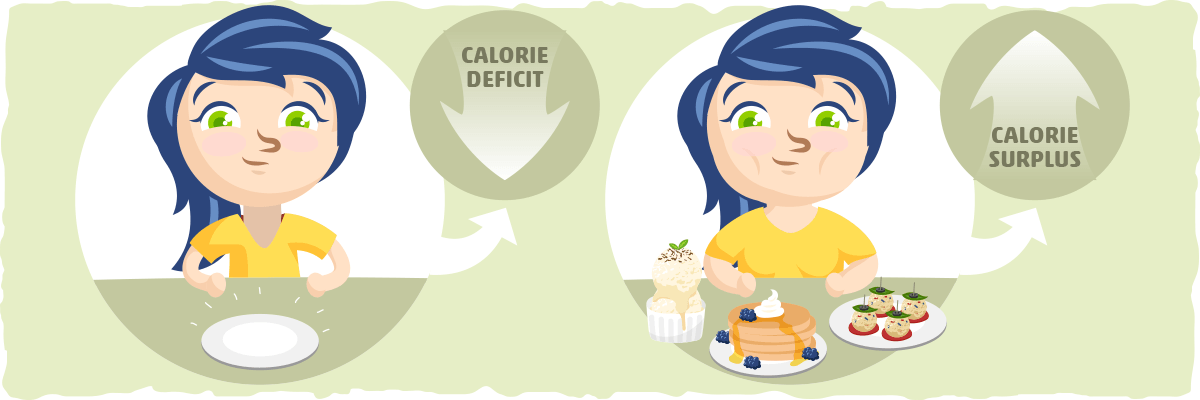
There is so much confusion regarding which macronutrient makes us fat. There is one group that believes fat makes us fat and another that believes carbs make us fat — even protein is being vilified in some diet groups.
The funny thing is that everyone is partly right, yet mostly wrong. The truth is that every macronutrient can be stored as fat in some way, but those macronutrients will not be stored as fat unless you are in a calorie surplus (i.e., you consume more calories than you need to maintain your weight).
By contrast, when you are in a calorie deficit (i.e., you consume fewer calories than needed to maintain your weight), you will burn your stored energy sources, including body fat. Thus, the key to weight loss and weight gain is calorie consumption.
Taken one step further, this means that the best way to lose weight is by following a diet that improves your health while also making you feel satiated and energized enough that eat you significantly fewer calories than before. For many people, the ideal fat loss diet is the keto diet for these exact reasons.
On the other hand, if you eat a ton of fat to the point that it puts you in a calorie surplus, you will gain fat. Yes, the fat will be stored as fat, but this doesn't mean that fat makes you fat. It is your calorie consumption that determines whether or not you burn the fat or gain it.
Now that you know the basic principle of weight loss, another question may come to mind: "Won't eating fat keep you from burning body fat?"
Won't Eating Fat Stall Your Fat Loss?
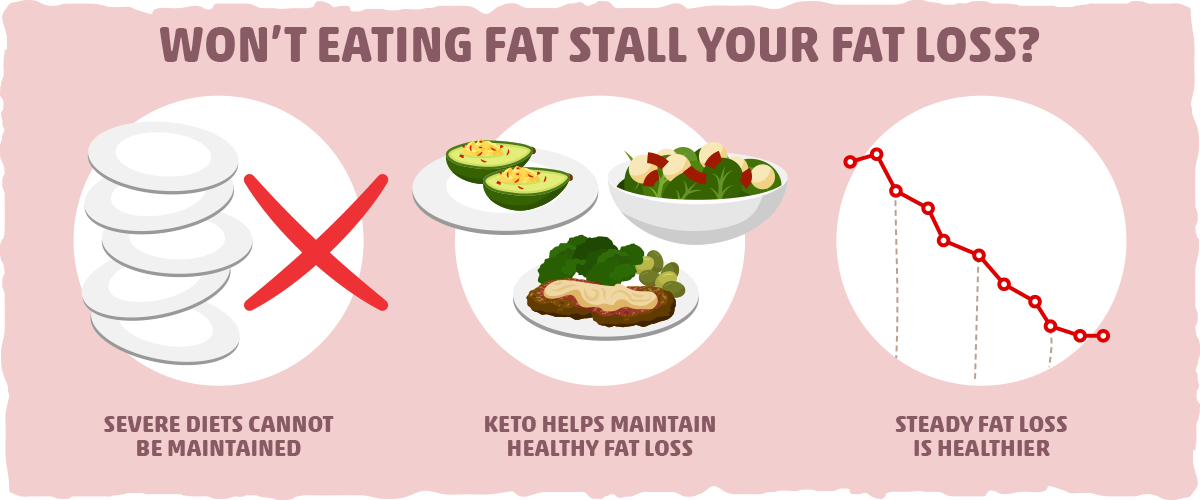
Technically, eating any source of calories will stall fat loss to some degree. As you eat more calories (from fat, carbs, and/or protein), you will hinder your fat loss more and more until you reach a calorie surplus. Once you are in a calorie surplus, you will start to gain fat.
The fastest way to lose fat is by consuming no calories at all. However, along with the rapid fat loss that this dietary strategy evokes, you will also lose muscle mass, cause hormonal issues, and become deficient in vitamins and minerals.
On top of that, the weight that is lost during fasting (or severe calorie restriction) is much more likely to be regained once that person returns to their normal way of eating.
In other words, prolonged fasting (not intermittent fasting) and severe calorie restriction are the least healthy and sustainable ways to lose weight. In contrast, the keto diet will allow you to maintain a healthy calorie deficit while meeting most, if not all, of your body's nutrient needs.
So, although you will be stalling fat loss by eating calories (mostly calories from fat), you will still lose weight at a steady pace without forfeiting your health and vitality in the short- and long-term.
Finding Your Balance: How Much Fat on Keto Works For Your Lifestyle?
Since fat will be your primary source of calories on the keto diet, you will be using fat as a lever to help you meet your body composition goals. In other words, to gain or lose weight, you will have to increase or decrease your fat intake. It's that simple.
Although you can guesstimate how much fat you need to eat based on trial and error, I recommend using our keto calculator as a starting point. It will give you a fat intake goal based on your height, weight, gender, activity levels, and goals.
By staying relatively close to what the calculator suggests, you should be able to get the results you are looking for. To ensure that you are on the right track, check your results after 3-5 weeks and follow the recommendations below that apply to your situation.
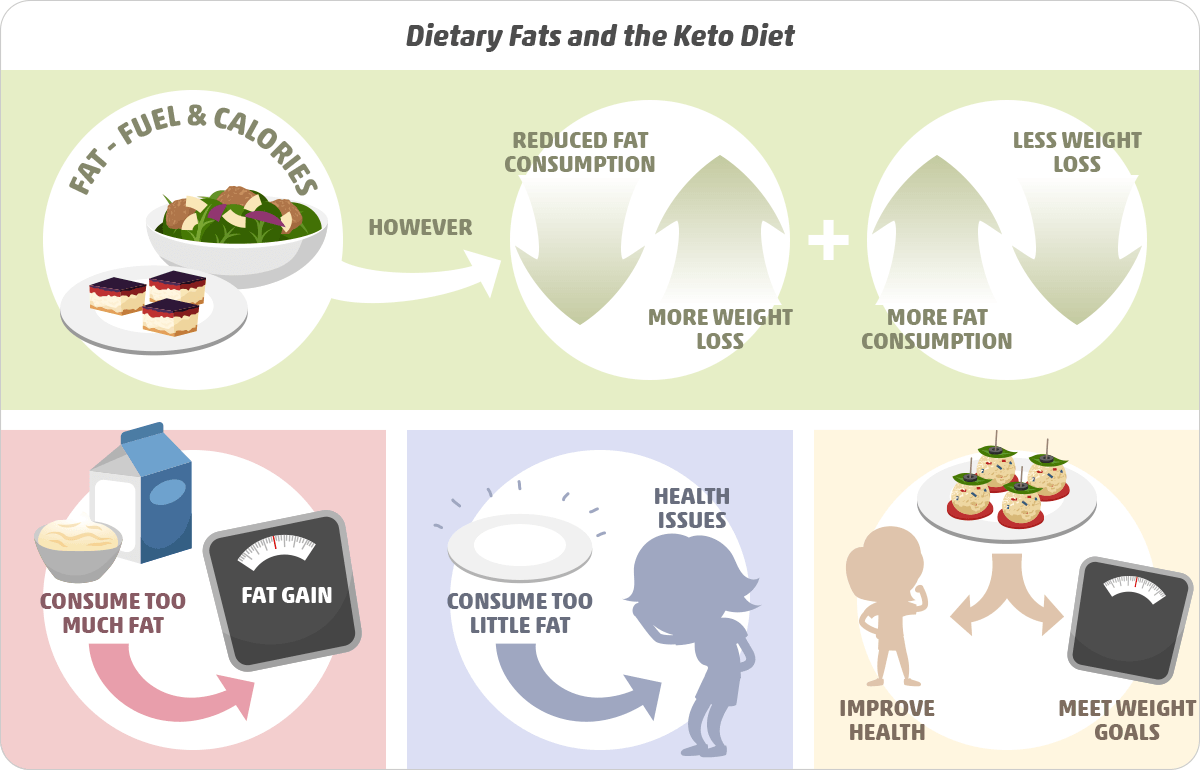
For those of you who want to lose weight, here's what you should look for and what you can about it:
- If you are losing weight at a rate of 1 to 2 pounds per week, then keep doing what you are doing until you plateau. Once your weight loss stalls, follow some of the suggestions in our article on busting through plateaus.
- If you lost less than 1 pound per week and are not satisfied with the results, I recommend increasing your calorie deficit by 5 to 10% (but do not exceed a 30% calorie deficit), tracking your calorie consumption, or following the other weight loss boosting strategies that you'll find in this article.
- If you are gaining weight, I recommend increasing your calorie deficit by 5 to 10% (but do not exceed a 30% calorie deficit), tracking your calorie consumption, or following the other weight loss boosting strategies that you'll find in this article.
- In each case, make sure your waist circumference (around belly button) is steadily decreasing as well. This is a much better indicator of fat loss than relying solely on tracking your weight.
For those of you who want to gain muscle, here's what you should look for and what you can about it:
- If you are steadily gaining weight with little to no increase in waist circumference, then keep doing what you are doing. When your results slow or plateau, try following the relevant strategies in our guide to keto bodybuilding.
- If you are losing weight, I recommend increasing your calorie consumption by 5% and make sure you are eating enough protein (at least 1 gram per pound of lean body mass). You can also check out the other suggestions in our guide to keto bodybuilding to help you gain more muscle mass.
- If you are looking to gain muscle and lose fat at the same time, make sure you take waist and limb circumference measurements. The circumference of your waist should be steadily decreasing as your limb circumferences (upper arms, upper legs, etc.) are steadily increasing. To lose fat and gain muscle at the same time, I recommend following the relevant protein suggestions in our guide to keto bodybuilding and decreasing your fat intake, so you are in a 5-15% calorie deficit (the intake that will allow you to lose approximately 0.5 to 1% of your body weight per week and no more).
In general, the amount of fat you need to eat depends on your goals and the pace at which you are achieving those goals.
Want to lose fat? Decrease your fat consumption until you start losing weight at a steady rate.
Want to gain muscle? Increase your fat consumption (and eat the right amount of protein) until you gain weight (mostly muscle) at a steady rate.
Want to verify that you are losing (or not gaining) fat? Use your waist circumference as a proxy measure for how much fat you are losing.
The principles behind reaching your goals are simple — but, in many cases, they are not easy to follow. This is why we added the next couple of sections to this article to help you stay on track.
How to Increase Your Keto Diet Fat Intake
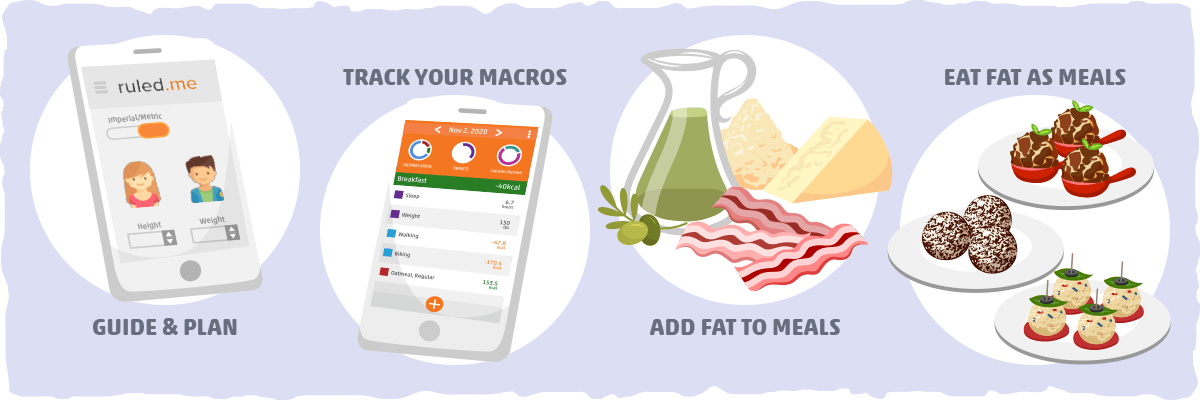
After you've figured out how much fat you need to eat (by using a keto calculator or guesstimating with the help of our keto guide), you will probably be wondering how it is possible to eat that much fat in one day.
Fortunately, fat is one of the easiest macronutrients to add to your meals. By simply drizzling some healthy oils on top of your meals, having an extra serving of bacon or cheese, or adding fat bombs to your diet, you will be able to increase your fat intake almost effortlessly.
However, it is easy to overdo it once you start adding more fats into your daily diet. This is why we recommend using a calorie tracker like MyFitnessPal or Cronometer to help you figure out how much fat you need and when you are adding too much.
To get you started, read through our guide to tracking carbs (and calories) on keto. Using a calorie tracking app and our keto calculator together will provide you with all the info you need regarding your fat intake.
Once you know how much fat you need to eat, make sure you consider the source of your fats. It is best to consume healthy fats whenever possible.
The Best Sources of Healthy Fats for the Keto Diet
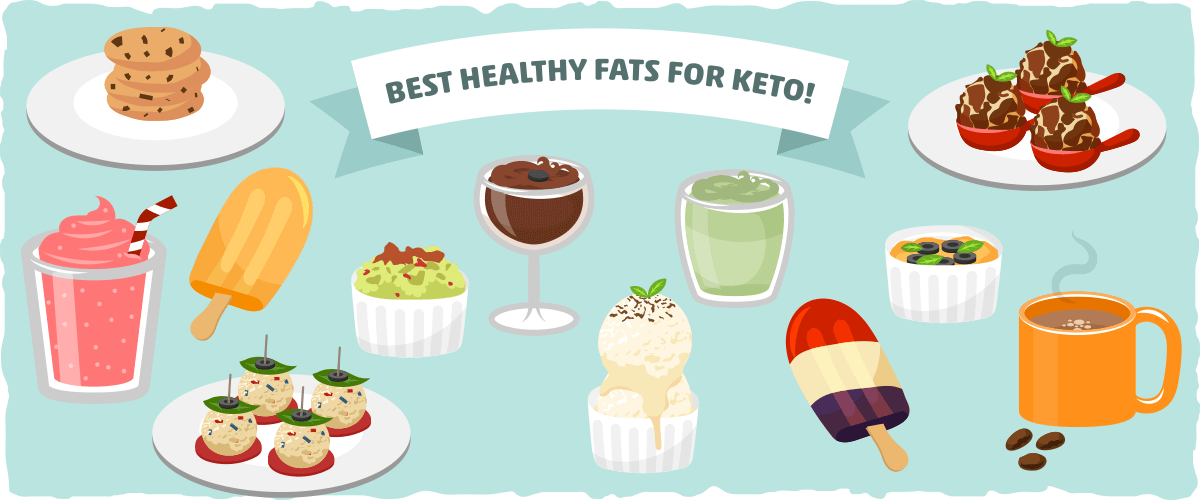
There are many foods that can provide you with healthy fats on the ketogenic diet. The best sources are whole foods like:
- Egg yolks — pasture-raised eggs are healthiest
- Olives — Any olives will do. Just make sure they have no added vegetable oils or sugars.
- Healthy oils — coconut oil*, olive oil, MCT oil, and avocado oil
- High-fat nuts — macadamias, pecans, almonds, etc. (macadamias are best)
- Fatty fish — salmon, sardines, etc.
- Avocados — Don't like them plain? Try Egg Salad Stuffed Avocado, Bacon and Roasted Garlic Guacamole, or Simple, Delicious Guacamole
- Butter or ghee* — 100% grass-fed butter and ghee are healthiest. Use ghee if you are sensitive to dairy proteins.
- Coconut butter* — make sure it has no added sugars.
- Cocoa butter* — Use it to make your own keto chocolate or fat bombs.
- Low-carb chocolate — If not sweetened with stevia or another low carb sweetener, make sure it's at least 80% cocoa content or higher, as the carbs can add up quickly. Here is an example of low carb friendly chocolate that you can try.
- High fat cheeses* — mascarpone cheese, cream cheese, cheddar cheese, etc.
- Full fat yogurt* — be mindful of the net carbs in the yogurt or make your own keto coconut cream yogurt.
- Fatty cuts of meat* — pepperoni and bacon, for example, are some of the fattiest meats you can have.
*Asterisked items contain fats that may increase cholesterol levels and heart disease risk in some people. If your cholesterol levels are unhealthy and heart disease runs in your family, then it may be best to limit these foods. For more information on the keto diet and cholesterol, feel free to check out this article.
And you can combine these keto foods into delicious homemade fatty meals and snacks like:
- Homemade Guacamole — Bacon and Roasted Garlic Guacamole and Simple, Delicious Guacamole are some delicious keto-friendly recipes you can try.
- Fat Bombs — To learn how to make your own, check out our guide to fat bombs.
- Cheese Dips or Fondues — Instant Pot Artichoke Dip, Spicy Sausage Cheese Dip, and Personal Pan Pizza Dip are some of our favorite keto dips. Enjoy them with keto-friendly veggies, pork rinds, or keto chips.
- Keto Ice Cream — Here is a link to the ten best keto ice cream recipes for you to try.
- Homemade Keto Popsicles — Berry Bomb Pops, Cinnamon Roll Pudding Pops, Raspberry Lemon Popsicles, etc.
- Ketoproof Coffee — Learn how to make your own by clicking here.
- Iced Ketoproof Green Tea — Not a fan of coffee? Try this energy-boosting beverage
- Keto Smoothies and Shakes — Some of our favorite keto smoothies are the Peanut Butter Caramel Milkshake, Blueberry Banana Bread Smoothie, McKeto Strawberry Milkshake, Cucumber Spinach Smoothie, Blackberry Chocolate Shake, and Keto Tropical Smoothie. Feel free to add your favorite low-carb protein powder to your shake or smoothie to help you meet your protein needs and build muscle.
- Keto Chocolate Mousse — Keto Mocha Mousse is one of my favorite mousse recipes.
- Keto Cookies — There are dozens of keto cookie recipes that you can find online. Here are some of our favorites: Low Carb Chocolate Chip Cookies, Crisp Meringue Cookies, Keto Buckeye Cookies, and Keto Snickerdoodle Cookies.
For more ideas, see our ketogenic diet food list and our keto snack list.
Fat Sources to Avoid and Limit on the Keto Diet
Not all fats are "good" or "healthy" fats, especially when you're on a high-fat, low-carb diet.
To ensure optimal health on keto, we recommend avoiding the following fat sources:
- Any partially or fully hydrogenated oils
- Refined oils that are high in omega 6's (e.g., safflower, sunflower, canola, corn, and soybean oil)
- Mayonnaise, margarine, spreads, and dressings that contain these oils.
Certain individuals may also need to limit their consumption of foods high in saturated fat (such as butter, coconut oil, beef, and lamb). This is because high intakes of saturated fat can impair LDL cholesterol levels for some people.
If this is the case for you, then a Mediterranean version of the ketogenic diet may be a better option. This approach emphasizes specific keto-friendly fat sources that are high in monounsaturated and/or polyunsaturated fatty acids and lower in saturated fat. To learn more about the Keto Meditteranean diet, click here.
The Fat Intake Spectrum for Keto: What Happens If You Undereat or Overeat?
Now that you know how much fat you need to eat and how to fit it all into your keto diet, you have one of the most critical pieces of your diet success figured out.
As you begin to implement these changes, however, you'll notice that it is nearly impossible to hit your fat intake goals perfectly every day. In fact, throughout your keto diet, you will have days when you eat way too much fat and other days when you are not even close.
Fortunately, you don't have to be 100% exact with your fat intake to get the results you want. The only time you'll have to make adjustments is when what you eat is significantly different from what is recommended above.
What does this mean exactly? Let's take a closer look at each side of the spectrum to find out.
One Side of the Spectrum: What If You Don't Meet Your Fat Goals?
When you don't meet your fat goals, it's not a big deal at all. As long as you are restricting carbs and eating enough protein, missing your fat goals will only lead to more fat loss.
However, it is best to avoid being in a steep calorie deficit consistently because you will eventually experience adverse effects. Hunger pangs will hit you harder, your metabolism will slow down, and your health and vitality will begin to deteriorate.
For these reasons, it is best to make sure you are eating enough fat to keep your calorie deficit below 30% on most days. This will allow you to lose weight in a way that won't slow your metabolism as much and impair your health.
If you are struggling to eat enough fat to maintain a 30% calorie deficit, find a way to fit more of the healthy fats from the previous section into your diet. My favorite (and most convenient) strategy is to add a couple of extra tablespoons of healthy oils to my sauces, dressings, soups, smoothies, and curries when I know I need to fit some extra fats in.
The Other Side of the Spectrum: Eating Too Much Fat
Despite what many low-carb proponents claim, you can gain fat from eating fat — and this can happen even if you are restricting carbs. However, as we learned earlier, you will only turn the fat you eat into body fat if you are in a calorie surplus.
In other words, the factor that determines whether or not you will lose or gain fat is not how much fat you eat, but how many calories you consume. This means that you can only overdo your fat intake if it puts you in a calorie surplus and causes you to gain fat.
Important note: we are solely talking from the perspective of weight loss right now. These statements do not apply to all health conditions.
To figure out if you are eating too much fat (before the weight on the scale starts going up), I recommend using our keto calculator and a calorie tracking app. The calculator will give you an idea of how much fat you need to eat and the calorie tracking app will let you know if you are above or below your fat goal for the day.
Other Macronutrients Are Important Too — A Quick Note on Protein and Carbs
Protein is an essential part of every diet. Without eating enough, you will be more likely to lose muscle mass, and your overall health and wellbeing will suffer.
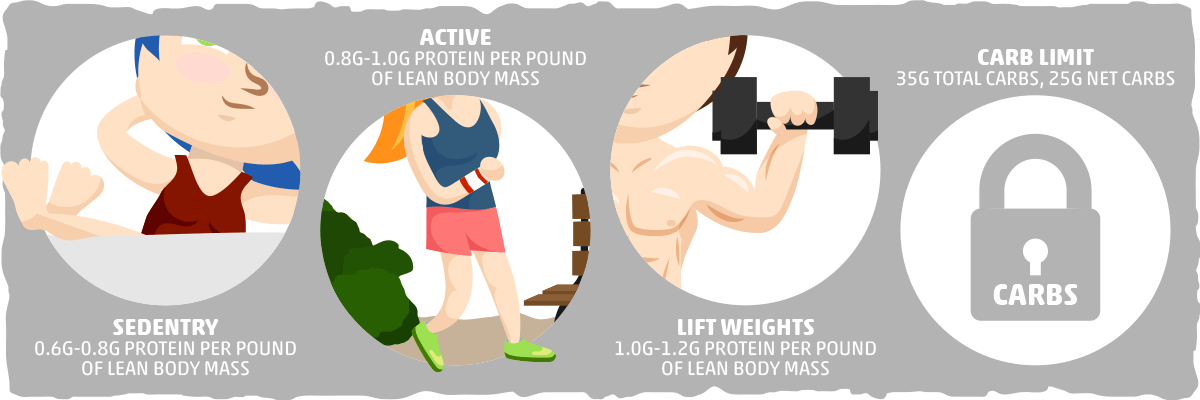
However, it is also important to keep your protein intake from getting too high or else you will impair your ability to get into and stay in ketosis while you are on the keto diet. Similar to fat, we must find a Goldilocks range of protein consumption (not too much, not too little — just right).
Here are some suggestions to help you find your ideal daily protein intake:
- If you're sedentary, we suggest between 0.6g and 0.8g protein per pound of lean body mass.
- If you're active, we suggest between 0.8g and 1.0g protein per pound of lean body mass.
- If you lift weights, we suggest between 1.0g and 1.2g protein per pound of lean body mass.
When it comes to carb consumption, we typically recommend a carb limit of 35 grams of total carbs and 25 grams of net carbs. If you eat more than this, then it may take longer for you to enter and sustain deeper levels of ketosis. Once daily carb intake is above 50 grams, sustained ketosis will probably not occur unless that person exercises at high-intensities regularly or is severely restricting their calories.
What about Ketosis? A Quick Note on Tracking Your Ketones
One of the primary goals of the keto diet is to reap the benefits of sustained ketosis. So, besides tracking your fat, protein, and carb intake, you may want to track your ketone levels as well.
The best indicator of ketosis on the ketogenic diet is your blood ketone levels. Even if you're eating lots of fat, very low carb, and moderate protein, you can't know for sure if you're on the right track unless you monitor your ketone levels. To learn about the best ketone tracking methods, check out our guide to measuring ketosis.
Putting It All Together — Eating Fat on the Ketogenic Diet
Fat is essential for our health in many ways (that you can learn about in this article). While you are on the keto diet, it plays a significant role in dictating whether or not you lose and gain weight as well.
Since fat is your primary source of calories when you are restricting carbs, we must not underestimate its importance. If you don't eat enough, you will run the risk of slowing your metabolism, increasing your hunger and cravings, and impairing your health and vitality. In contrast, if you eat too much fat, you will start to turn it into body fat and gain weight in an unhealthy way.
To achieve your goals, it is essential that you eat the right amount of fat while you are on keto. The easiest way to do this is by following these three steps:
- Use our keto calculator.
- Track your macros with a calorie tracking app. (Use our guide to help you with this.)
- Add healthy fats to your meals until you are close to your recommended fat intake.
Yes, it is that simple — but don't forget about your other two macronutrients (protein and carbs) and ketosis. Each one plays a vital role in your keto diet success as well.
Sources:
- What is healthy weight loss? — CDC
- Keto & Weight Loss — ruled.me
- Should I Count Calories on a Ketogenic Diet? — ruled.me
- The Hungry Brain — STEPHAN J GUYENET, PhD
- Obesity Energetics: Body Weight Regulation and the Effects of Diet Composition. — NCBI
- Effects of low-carbohydrate vs low-fat diets on weight loss and cardiovascular risk factors: a meta-analysis of randomized controlled trials — NCBI Bookshelf
- Very-low-carbohydrate ketogenic diet v. low-fat diet for long-term weight loss: a meta-analysis of randomised controlled trials — British Journal of Nutrition
- 10 Science-Backed Reasons to Eat More Protein — Healthline
Keto Diet How Many Grams of Fat Should
Source: https://www.ruled.me/how-much-fat-should-you-eat-on-a-ketogenic-diet/